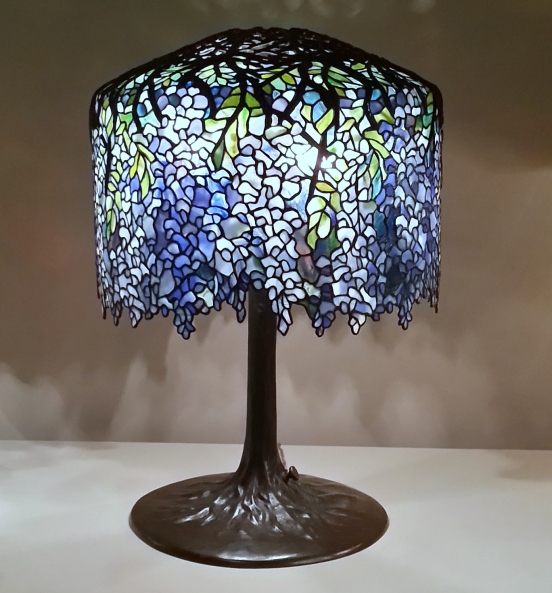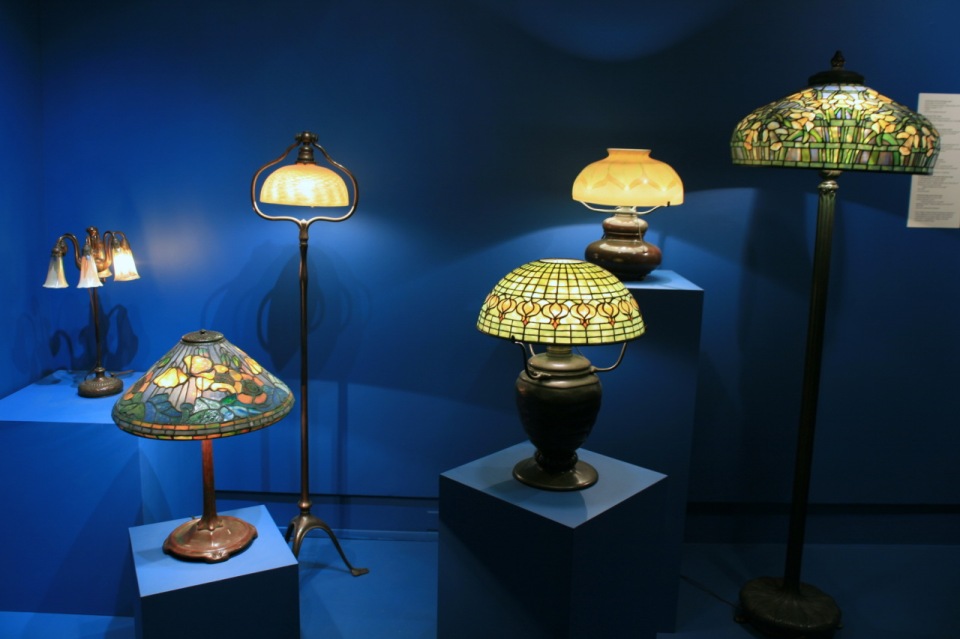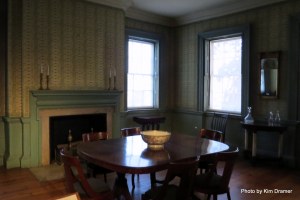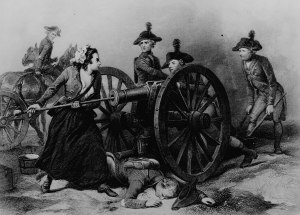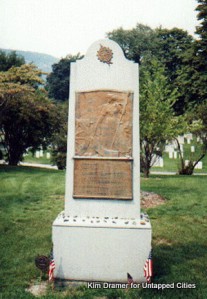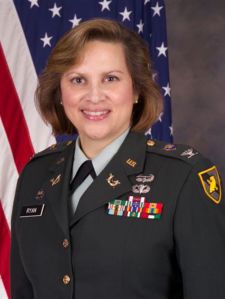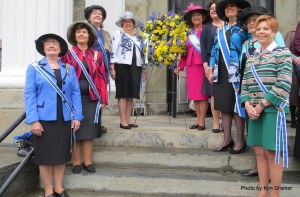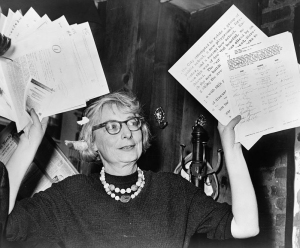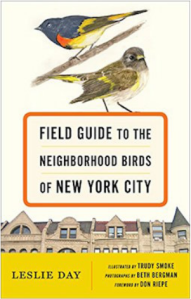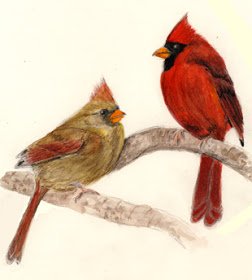Arriving in 1627, Dorothy Creole is known as the city’s first black woman. That year, three enslaved African women set foot on the southern shore of Manhattan, arriving in the Dutch colony of New Amsterdam (Nieuw Amsterdam). Property of the Dutch West India Company, these women were brought to the colony to become the wives of enslaved African men who had arrived in 1625. One of these women was named Dorothy Creole, a surname that she acquired in the New World and likely began as a descriptive term.
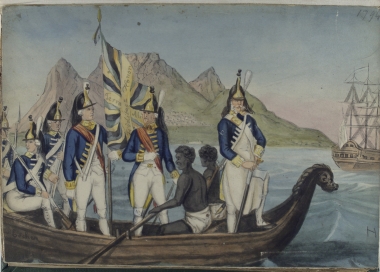
General Research Division, The New York Public Library. “Dutch soldiers in a boat with slaves from the Colonies, Africa” The New York Public Library Digital Collections. 1910.
Dorothy’s world was one in which West Africans and Europeans had mixed and traded for more than two centuries. The Dutch had established trading posts in present-day Angola on the Slavenkust or Slave Coast to acquire slaves for their New World colonies. It is also the year of the supposed sale of the island of Manhattan to the Dutch by native inhabitants for the equivalent of 24 dollars of trade goods. What is significant to Dorothy Creole’s story is that by 1625, New Amsterdam was a place where white, blacks and native inhabitants had significant interaction.

The Miriam and Ira D. Wallach Division of Art, Prints and Photographs: Print Collection, The New York Public Library. “Nieu Amsterdam.” The New York Public Library Digital Collections.
An early copper plate print of New Amsterdam shows the mix of Europeans and Africans in the fledgling colony. In the foreground, a Dutch couple displays the agricultural wealth of the colony, chief among these being tobacco, very much in vogue in the coffee houses of Europe. The print circulating in Europe was designed to attract European colonists for New Amsterdam. The Dutch West India Company wanted New Netherland to be the granary of its western Atlantic empire. Prospective colonists were attracted by the abundance of rich farm land, offering them the possibility of becoming wealthy landowners. In the middle ground of the print, figures of black men and a woman in African garments carry goods to and fro on their head. Along with the brimming basket of foodstuff held by the Dutch woman, they are a troupe of wealth and abundance. In the background, ships are shown arriving and departing from the colony with wealth from trade clearly illustrated.

Het West Indisch Huys, Amsterdam 1655, engraving. Amsterdam, Stadsarchief Amsterdam. Frank Schulenburg via Wikimedia Commons.
The colony was a business venture of the Dutch West India Company (DWIC); and Dorothy Creole was a part of that business. The agricultural profits of the DWIC came from New World products that relied upon slave labor from Africa. The company’s headquarters in Amsterdam boasted warehouses filled with tobacco, sugar and coffee that had been produced with slave labor from Africa and unloaded in Europe from the holds of ships returning from the New World. On Manhattan, Dorothy became a tiny, but vital link in the chain of the company business.
When Dorothy arrived in New Amsterdam, it was a hardscrabble village of thirty wooden houses clinging to the southern tip of Manhattan, today’s financial capital of the world. But it was also, quite literally, the island at the center of the Dutch world, linking the New World with Africa and the European continent.

Lionel Pincus and Princess Firyal Map Division, The New York Public Library. “Nieuwe Werelt kaert” The New York Public Library Digital Collections. 1668.
The company had a lucrative monopoly on the fur trade with the Indians. By the end of the 17th century, the beaver had been hunted to near extinction in Europe. At the same time, Europe was undergoing the Little Ice Age,” a period of expanding glaciers and falling temperatures.

Rare Book Division, The New York Public Library. “T’Fort Nieuw Amsterdam op de Manhatans.” The New York Public Library Digital Collections.
Fur trade with the Indians was crucial to the financial success of the colony. Colonists of African descent became key to maintaining good relations between the Dutch and the Indians. An engraving from the late 17th century shows a hunter holding a beaver pelt, while wearing another on his head.
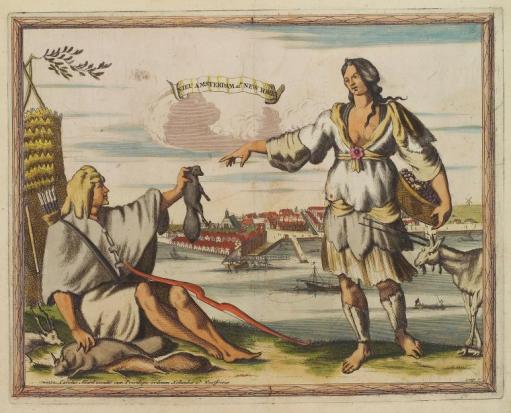
The Miriam and Ira D. Wallach Division of Art, Prints and Photographs: Print Collection, The New York Public Library. “Nieu Amsterdam at[que] New York” The New York Public Library Digital Collections. 1673.

Seal of New Netherlands. This photo taken at the New York State Museum, July 29, 2009. Matt H. Wade via Wikimedia Commons.
A beaver appears on the seal of New Netherlands, underlining its importance to the colony. Beaver pelts were valued for making broad-brimmed hats. Moreover, wearing a beaver hat was believed to make the wearer more intelligent. The oil from the hat, when rubbed on one’s hair, was said to sharpen a person’s memory.
These hats, both warm and water repellent, were also conspicuous indicators of status and wealth. The wealthy men depicted in Rembrandt’s Syndics of the Drapers Guild are pictured with such hats that were made from beaver pelts sent to Holland from the New Amsterdam colony.

The Syndics of the Amsterdam Drapers’ Guild, known as the ‘Sampling Officials’ by Rembrandt (1606-1669), 1662, oil on canvas. Collection of the Rijksmuseum. DcoetzeeBot via Wikimedia Commons.
The New Amsterdam fur trade that was so crucial to the success of the Dutch colony had been established Jan (Juan) Rodrigues. Rodrigues was the first known person of African descent to arrive on Manhattan. He arrived as a free man in 1613. A black sailor from Hispaniola (now Haiti and the Dominican Republic), he had set up a trading post with the native Lenape people on Manhattan Island.
The future of the fur trade, and indeed, the colony itself, was jeopardized by the actions of the DWIC director-general, Willem Kieft. Kieft’s War, (also known as the Wappinger War), was a conflict between the settlers of the nascent colony and the local native population.
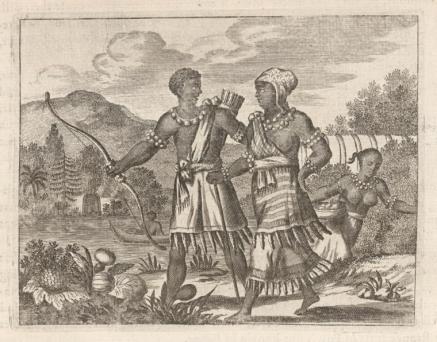
Art and Picture Collection, The New York Public Library. “Kleding der Nieuw-Netherlanders.” The New York Public Library Digital Collections. 1671.
Lasting from 1643-1645, the conflict grew from Kieft’s unauthorized order for an attack on the Lenape camps, in which the Dutch massacred the native inhabitants. This action had unified the local Algonquian tribes against the Dutch, causing many attacks on both sides. Dutch settlers began to return to the Netherlands, slowing the growth of the nascent colony.

General Research Division, The New York Public Library. “Dutch soldiers in a boat with slaves from the Colonies, Africa” The New York Public Library Digital Collections. 1910.
Part of Kieft’s solution was to use the African population as a buffer between the Indians and the Dutch. At the height of the fighting of the Dutch and Indian War, Kieft opened the frontier north of the tiny colony for settlement by blacks.
Company records show that in 1644, one Paulo d’Angola and other enslaved Africans petitioned the Dutch West India Company for their freedom, as well as the freedom of their wives. The wife of Paulo d’Angola was none other than Dorothy Creole. Records also show that the previous year, Dorothy had adopted a young black child who had lost his parents. Kieft conditionally granted the petition. He conferred what was called “half-freedom” declaring them “free and at liberty on the same footing as other free people here in New Netherland.” This group of former slaves was also granted title to land in the Dutch colony. Only the names of men appear in records. Some historians feel that half-freedom for the petitioners’ wives came only when these men paid for the women’s half-freedom.
These families received the right to own land north of the settlement to farm and settle. Called the “Land of the Blacks” of the “Negro frontier,” this two-mile stretch from Canal Street to today’s 34th Street, was established as one of the first free black communities in North America, clearly outside the boundaries of the colony.

Lionel Pincus and Princess Firyal Map Division, The New York Public Library. “Map of the original grants of village lots from the Dutch West India Company to the inhabitants of New-Amsterdam (now New-York) lying below the present line of Wall Street : Grants commencing A.D. 1642” The New York Public Library Digital Collections. 1897.
But there were conditions to half-freedom. The half-free men and women were required to pay a yearly tax of “30 skepels (about ¾ bushel) of maize, wheat, peas or beans, and one fat hog” and work for the colony when required. Men were required to serve in the militia. These conditions were often required of the city’s free, white population. The children of these half-free men and women, however, would be slaves, tying these families to the colony via perpetual servitude.
The grant that Dorothy Creole and Paulo d’Angola likely received was sizeable, from eight to twelve acres. This would make Dorothy Creole among the largest black landowners in the city’s history. There was enough land for a kitchen garden, crops, and pastureland for animals. Dorothy and Paulo likely planted orchards of apples, peaches, plums and cherries. They built their house themselves, using wood and thatch, like those in the city proper, south of the palisade at Wall Street that was built in 1653, using labor from these freed black men. It was a permeable barrier built to protect the colony while allowing the passage of valuable goods to enter the city.

Art and Picture Collection, The New York Public Library. “Section Of Wall Street Palisade.” The New York Public Library Digital Collections. 1887.
The Journal of Jasper Danckaerts (1679-1680) describes this area and its inhabitants:
These negroes were formerly the proper slaves of the (West India) company, but, in consequence of the frequent changes and conquests of the country, they have obtained their freedom and settled themselves down where they have thought proper, and thus on this road, where they have ground enough to live on with their families.
Minetta Lane in today’s Greenwich Village is all that remains of a road, formerly called the Negroes’ Causeway, that ran alongside Minetta Creek. This road connected several of the farms in the Land of the Blacks with the colony that was protected y the Wall Street Palisade.
Records have no mention of either Dorothy or Paulo until 1653, when one Dorothy d’Angola, then a widow, marries Emanuel Pietersen. Nor do we learn about the fate of her adopted child, or property that survived her demise and might have passed down to her children. There is no record of her place of burial. But we can bring several facts about the fate of Dorothy and other blacks in New Netherlands to bear.
Willem Kieft’s rule as director-general had not met with the approval of the DWIC. He was called back to the Netherlands in disgrace, and died when he was shipwrecked. He was replaced by Pieter Stuyvesant, a seasoned administrator and soldier, who was counted upon to renew the fortunes of the colony. In 1664, Stuyvesant surrenders the colony to the British without firing a shot, and New Amsterdam became New York.
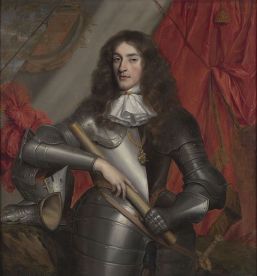
Portrait of Ernest August, Duke of York (1674-1728), by an unidentified painter, oil on canvas. In the collection of the Royal Collection. Sir Gawain via Wikimedia Commons.
The now British colony was named for James II, the Duke of York, later both James II and VII. The Duke was a principle investor in the Company of Royal Adventures Trading To Africa—a name that boded ill for the future of blacks in the colony. Under the British, life for black New Yorkers, enslaved and free, changed dramatically. Laws passed by the British following the 1712 Slave Uprising, prohibited freed African New Yorkers from owning real estate. They were forced to forfeit their property to the British crown. Likely, the farm established by Dorothy and Paulo was lost in this way.
Like the Jews of New Netherlands, blacks were prohibited from burying their dead within city walls. In 1673, on a plot of land off today’s Broadway, then the Post Road to Boston, a Dutch woman named Sara Van Bosum allowed the burial of Africans on her property. The burial ground continued to grow with the city’s increasing black populations. Eventually, it comprised of about five city blocks, and held hundreds of burials. It could well be the final resting place of Dorothy Creole.

Area of archaeological excavation by Howard university marked on a map by Francis Maerschalck (d. 1776). A Plan of the City of New York from an Actual Survey, anno Domini M{D}CCLV .Section showing the Collect Pond and “Negros Burial Ground”. New York City in 1754; map was published in 1755 by Gerardus Duyckink II (1723-1797). Geographer at large blogspot.com via Wikimedia Commons.
By 1716, after a half-century of British rule, the African Burial Ground was one of the few pieces of land in Manhattan controlled by blacks. By 1795, the land was subdivided and sold for house lots. Though clearly marked on maps, the status of the site as burial ground was forgotten, only to emerge centuries later during 1991 excavations for the Ted Weiss Federal Office Building at 290 Broadway.
When it was revealed that the site held the bones of formerly enslaved residents of Manhattan, the descendant community of New Yorkers arose with a single voice. They demanded a respectful recovery of the remains, a study of the site for information on the city’s first African residents and a fitting reburial and monument.
The graves were notable for the lack of artefactual material, speaking to the poverty of those interred. Their bones, marked by period of malnutrition and physical stress, attest to lives of hardship and deprivation. Perhaps Dorothy’s bones are among those recovered from the site. No written records survive. There are upwards of 500 burials at the site, yet there are no inscriptions or markers. In other words, the only record we have of Dorothy Creole was written by the Dutch. She left us no written record, no marker, no image. Today, the site is a National Monument, known as the African Burial Ground. Educational initiatives about the lives of early black New Yorkers is explored.

Artist’s Impression of the African Burial Ground National Monument, U.S. National Park Service. Image uploaded by Rodney Leon via Wikipedia.com.
When Dorothy arrived in Manhattan, New Amsterdam was a colony with less than 200 souls. Today, the City of New York boasts a population of 8.5 million. One in four New York City residents identify as black or mixed heritage making it the US city with the largest population of blacks.
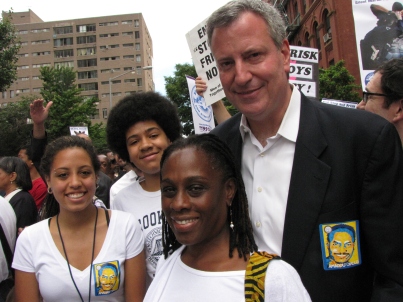
Mayor Bill de Blasio and Family, S&Q Silent March, June 17, 2012. Pancho S via Wikimedia Commons.
Arriving in 1667, Dorothy Creole is known as the city’s first black woman. In 2014, Charlene McCray, became the first black woman to assume the role of the city’s first lady. Ms. McCray serves as the chairwoman of the Commission on Gender Equity, spearheading initiatives to commission public art acknowledging the contributions of women to the city. She Built NYC aims to bring the contributions of women to our city throughout its history.
All traces of Dorothy Creole, the city’s first black woman, have been erased by time, by prejudice, by greed and by successive governments caring less for their inhabitants than the expansion of the Island at the Center of the World. But the name of Dorothy Creole, has been put forward as a candidate for consideration by the commission. Surely, a woman who helped forge links among three continents deserves a place in our textbooks, on our streets and in our hearts.
This article may be freely used by others in consideration of attribution only. 
